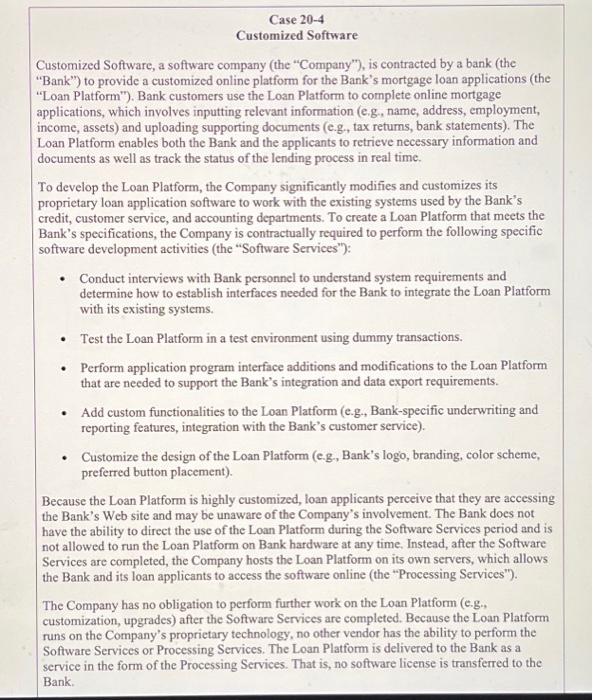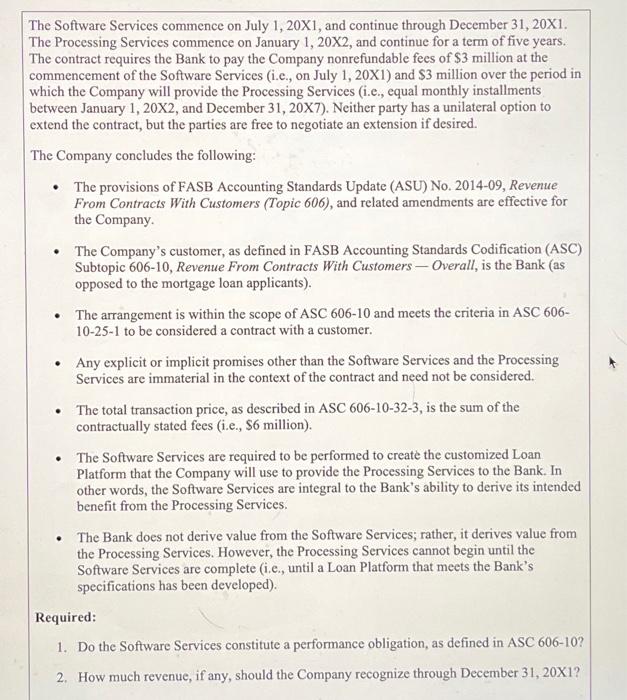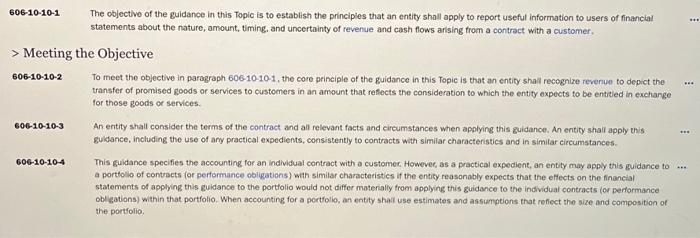
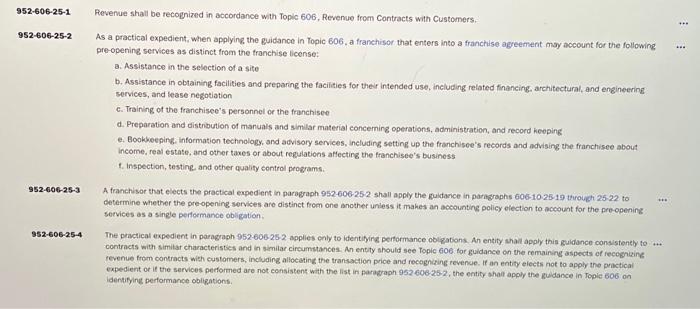
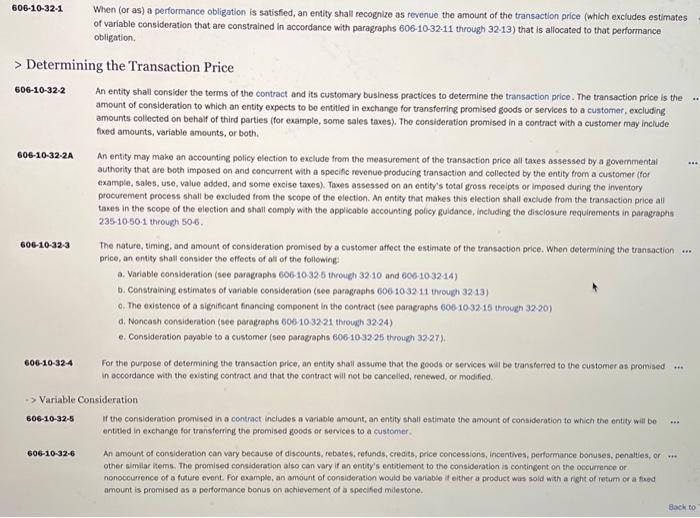
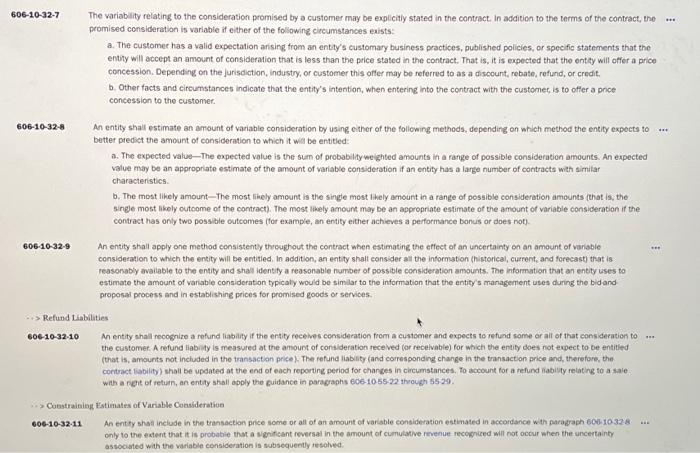
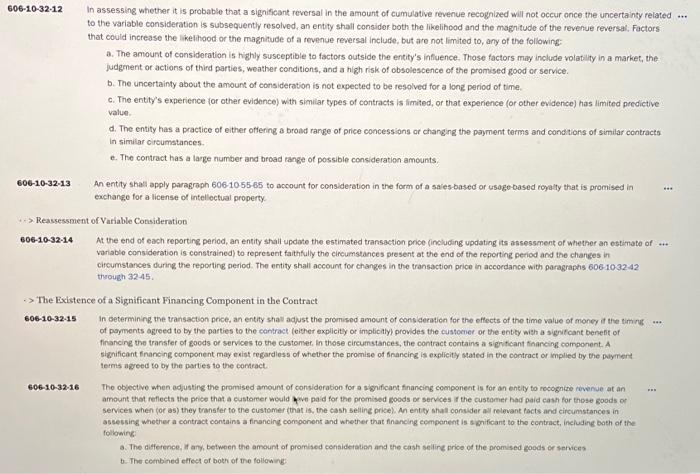
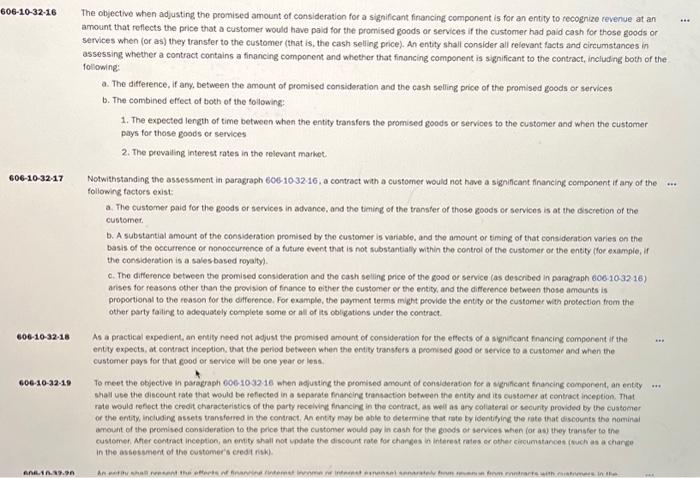
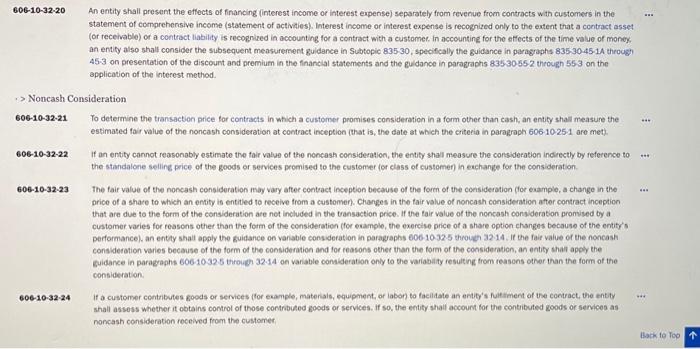
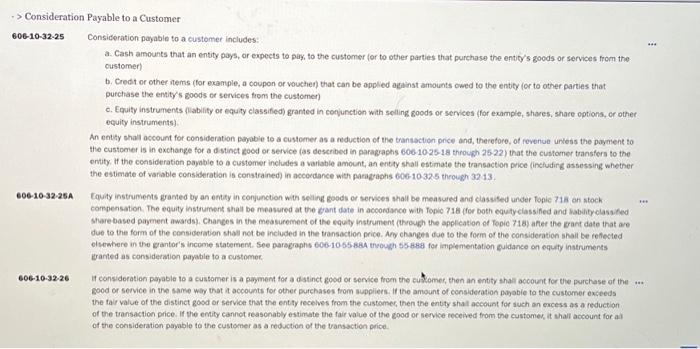
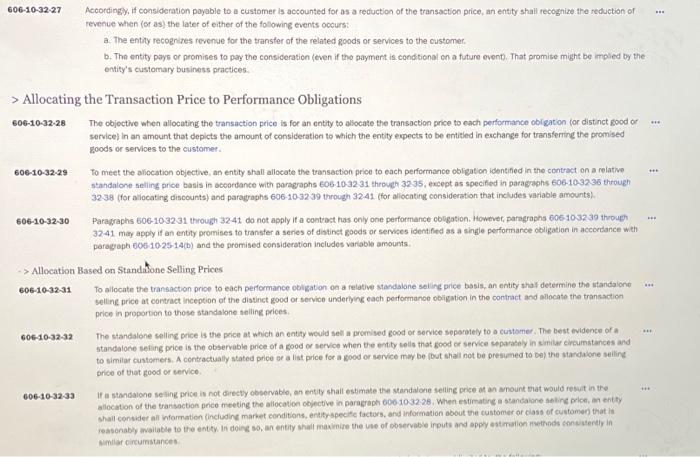
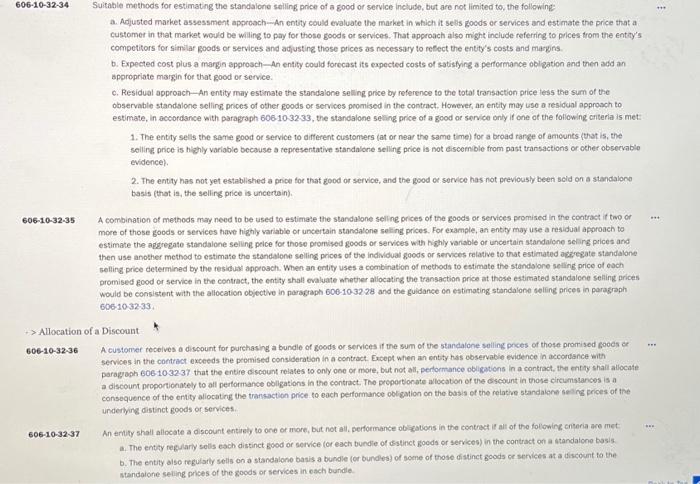
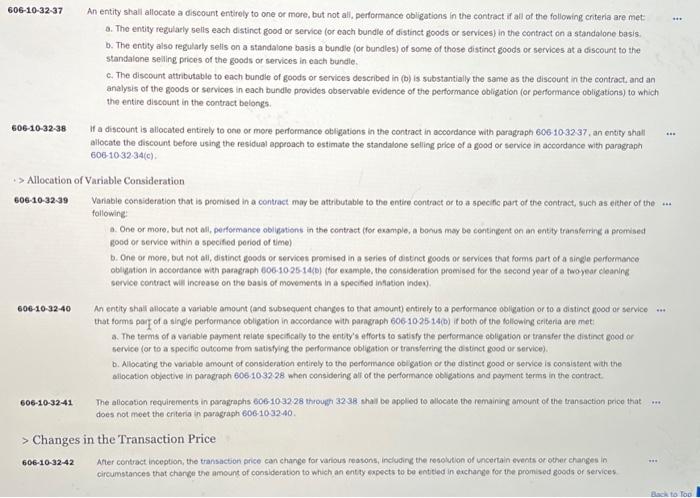
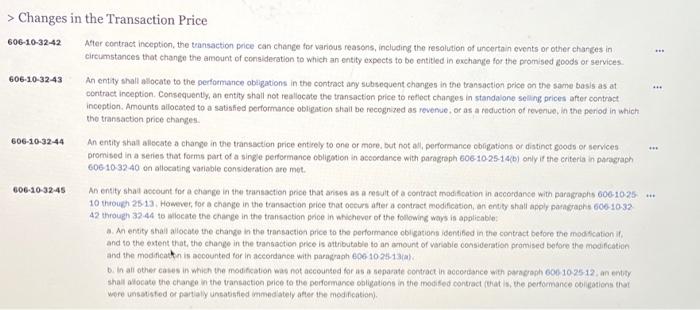
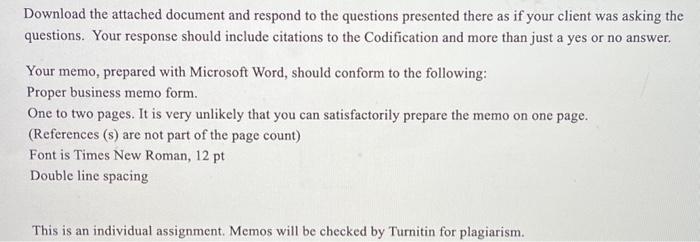
Case 20-4 Customized Software Customized Software, a software company (the "Company"), is contracted by a bank (the "Bank") to provide a customized online platform for the Bank's mortgage loan applications (the "Loan Platform"). Bank customers use the Loan Platform to complete online mortgage applications, which involves inputting relevant information (e.g., name, address, employment, income, assets) and uploading supporting documents (e.g., tax retums, bank statements). The Loan Platform enables both the Bank and the applicants to retrieve necessary information and documents as well as track the status of the lending process in real time. To develop the Loan Platform, the Company significantly modifies and customizes its proprietary loan application software to work with the existing systems used by the Bank's credit, customer service, and accounting departments. To create a Loan Platform that meets the Bank's specifications, the Company is contractually required to perform the following specific software development activities (the "Software Services"): - Conduct interviews with Bank personnel to understand system requirements and determine how to establish interfaces needed for the Bank to integrate the Loan Platform with its existing systems. - Test the Loan Platform in a test environment using dummy transactions. - Perform application program interface additions and modifications to the Loan Platform that are needed to support the Bank's integration and data export requirements. - Add custom functionalities to the Loan Platform (e.g., Bank-specific underwriting and reporting features, integration with the Bank's customer service). - Customize the design of the Loan Platform (c.g., Bank's logo, branding, color scheme, preferred button placement). Because the Loan Platform is highly customized, loan applicants perceive that they are accessing the Bank's Web site and may be unaware of the Company's involvement. The Bank does not have the ability to direct the use of the Loan Platform during the Software Services period and is not allowed to run the Loan Platform on Bank hardware at any time. Instead, after the Software Services are completed, the Company hosts the Loan Platform on its own servers, which allows the Bank and its loan applicants to access the software online (the "Processing Services"). The Company has no obligation to perform further work on the Loan Platform (e.g., customization, upgrades) after the Software Serviees are completed. Because the Loan Platform runs on the Company's proprietary technology, no other vendor has the ability to perform the Software Services or Processing Services. The Loan Platform is delivered to the Bank as a service in the form of the Processing Services. That is, no software license is transferred to the Bank. The Software Services commence on July 1, 20X1, and continue through December 31, 20X1. The Processing Services commence on January 1,20X2, and continue for a term of five years. The contract requires the Bank to pay the Company nonrefundable fees of $3 million at the commencement of the Software Services (i.e., on July 1, 20X1) and \$3 million over the period in which the Company will provide the Processing Services (i.e., equal monthly installments between January 1,20X2, and December 31,207 ). Neither party has a unilateral option to extend the contract, but the parties are free to negotiate an extension if desired. The Company concludes the following: - The provisions of FASB Accounting Standards Update (ASU) No. 2014-09, Revenue From Contracts With Customers (Topic 606), and related amendments are effective for the Company. - The Company's customer, as defined in FASB Accounting Standards Codification (ASC) Subtopic 606-10, Revenue From Contracts With Customers - Overall, is the Bank (as opposed to the mortgage loan applicants). - The arrangement is within the scope of ASC 606-10 and meets the criteria in ASC 60610251 to be considered a contract with a customer. - Any explicit or implicit promises other than the Software Services and the Processing Services are immaterial in the context of the contract and need not be considered. - The total transaction price, as described in ASC 606-10-32-3, is the sum of the contractually stated fees (i.e., $6 million). - The Software Services are required to be performed to create the customized Loan Platform that the Company will use to provide the Processing Services to the Bank. In other words, the Software Services are integral to the Bank's ability to derive its intended benefit from the Processing Services. - The Bank does not derive value from the Software Services; rather, it derives value from the Processing Services. However, the Processing Services cannot begin until the Software Services are complete (i.e., until a Loan Platform that meets the Bank's specifications has been developed). Required: 1. Do the Software Services constitute a performance obligation, as defined in ASC 60610 ? 2. How much revenue, if any, should the Company recognize through December 31,20X1 ? The objective of the guidance in this Topic is to establish the principles that an entity shall apply to report useful information to users of financial statements about the nature, amount, timing, and uncertainty of revenue and cash flows arising from a contrect with a customer. > Meeting the Objective 606-10-10-2 60010103 60010104 To meet the objective in paragraph 606-10-10-1, the core principle of the guidance in this Topic is that an entioy shall recognize revenue to depict the transfer of promised goods or services to customers in an amount that reflocts the consideration to which the entity expects to be entitied in exchange for those goods or services. An entity shall consider the terms of the contract and all relevant facts and circumstances when applying this guidance. An entity shall apply this guldance, including the use of ary practical expedients, consistently to contracts with similar characteristics and in similar circumstances. This guidance specifies the accounting for an individual contract with o customer. Howevec, as a practical expedient, an entity may appy this guidance to a portfolio of contracts (or performance obligations) with similar characteristics if the entity reasonobly expects that the effects on the financial statements of applying this guidance to the portfolio would not differ materially from applying this guidence to the individual contracts (or performance obleations) within that portfolio. When accounting for a portfolio, an entity shall use estimates and assumptions that refiect the size and composition of the portfolio. Reverue shall be recognized in accordance with Topic 606 , Revenue from Contracts with Customers. As a practical expedient, when applying the guidanco in Topic 606, a franchisor that enters into a franchise agreement may account for the following pre-opening services as distinct from the tranchise license: a. Assistance in the selection of a site b. Assistance in obtaining facilities and preparing the facilities for their intended use, including related financing, architectural, and engineering services, and tease negatiation c. Training of the franchisce's personnel of the franchisee d. Preparation and distnoution of manuals and similar material concerning operations, administration, and record heoping e. Bookheepiry, information technology, and advisory services, including setting up the franchisee's fecords and advising the franchisee about income, real estate, and other taxes or about regulations affecting the franchisee's business t. Inspection, testine, and other quality control protgams. A franchisor that elects the practical expedient in paragraph 952606252 shall apply the guidance in paragraphs 606-10.25-19 through 25.22 to determine whether the preopening servises are distinct from one another unless it mahes an accounting policy election to account for the pre-opening services as a single performance obligation. contracts with simitar characteristies and in similar circumstances. An entity should see Topic foe for guidance on the remaining aspects of recognizine revenue from contracts with eustomers, including allocsting the transoction price and recogncing revence. If an entity elects not to apply the practical expedient of if the services pefformed are not consistent with the list in paradraph 952606252 , the entity shaif apply the gudance in fopie 606 on identifying performance obligations. 0321 When (or as) a performance obligation is satisfied, an entity shall recognize as revenue the amount of the transaction price (which excludes estimates of variable consideration that are constrained in accordance with paragraphs 606-10-32-11 through 3213 ) that is allocated to that performance obligation. etermining the Transaction Price 0322 An entity shall consider the terms of the contract and its customary business practices to determine the transaction price. The transaction price is the amount of consideration to which an entity expects to be entitled in exchango for transferring promised goods or services to a customer, excluding amounts collected on behalf of third parties (for example, some sales taxes). The consideration promised in a contract with a customer may include foed amounts, variable amounts, or both. 10-32-2A An entity may make an accounting policy election to exclude from the measurement of the transaction price all taxes assessed by a governmental authority that are both imposed on and concurrent with a specific revenueproducing transaction and collected by the entity from a customer (for example, sales, use, value added, and some excise taxes). Taxes assessed on an entity's total gross receipts or imposed during the inventory procurement process shall be excluded from the scope of the election. An entity that makes this election shall exclude from the transaction price all taxes in the scope of the election and shall comply with the applicable accounting policy guidance, including the disclosure requirements in paragrophs 235-10-50-1 through 50-6. 10323 The nature, timing, and amount of consideration promised by a customer affect the estimate of the transoction price. When determining the transaction .... price, an entity shall consider the effects of all of the following: a. Variable consideration (see paragraphs 606-10-32.5 through 3210 and 606-10-32.44) b. Constraining estimates of variabie consideration (see paragraphs 6001032.11 through 32.13 ) c. The existence of a significant financing component in the contract (see paragaphs 6001032.15 through 3220 ) d. Noncash consideration (see paragaphs 606103221 through 32.24 ) e. Consideration payable to a customer (5e0 paragaphs 6061032.25 through 32.27 ). 210324 For the purpose of determining the transaction price, an entity shall assume that the goods or services wal be transforred to the customer as promised ... in occordance with the existing contract and that the contract will not bo cancelled, renewed, or modified. Variable Consideration 610325 610326 If the consideration promised in a contract includes a variable amount, an entity shall estimate the amount of consideration to which the entity wili be ... entuled in exchange for transferring the promised goods or services to a customer. An amount of consideration can vary because of discounts, rebates, refunds, credits, price concessions, incentives, performance bonuses, penalties, or .... other similar hems. The promised consideration also can vary if an entity's entudement to tho consideration is contingont on the occurrence or nonoccurrence of a futute event. For example, an amount of consideration would be variable it either a product was sold with a right of return or a faed amount is promised as n performance bonus on achievement of a specifed milestone. 60610327 The variability relating to the consideration promised by a customer may be explicitly stated in the contract. in addition to the terms of the contract, the promised consideration is variabie if either of the following circumstances exists: a. The customer has a valid expectation arising from an entity's customary business practices, published policies, or specific statements that the enty will accept an amount of consideration that is less than the price stated in the contract. That is, it is expected that the entity will offer a price concession. Depending on the jurisdiction, industry, or customer this offer may be referred to as a discount, rebate, refund, or credit. b. Other facts and circumstances indicate that the entity's intention, when entering into the contract with the customet, is to offer a pnce concession to the customer. 60610328 An entity shall estimate an amount of variable consideration by using, either of the following methods, depending on which method the entity expects to .... better predict the amount of consideration to which it wil be entitied: a. The expected value - The expected value is the sum of probability weighted amounts in a range of possible consideration amounts. An expected value may be an appropriate estimate of the amount of variable consideration if an entity has a large number of contracts with similar characteristics. b. The most likely amount-The most likely amount is the single most thely amount in a range of possible consideration amounts (that is, the single most likely outcome of the contract). The most likely amoun may be an appropriate estimate of the amount of variable consideration if the contract has only two possible cutcomes (for example, an entity either achieves a performance bonus or does not). 60610329 An entity shall apply one method consistenty thecughout the contract when estimating the effect of an uncertainty on an amount of variable consideration to which the entity will be entitied. In addition, an entity shalt consider all the information (historical, current, and forecast) that is reasonably available to the entity and shali identify a reasonable number of possible consideration amounts. The information that an enty uses to estimate the amount of variable consideration typicaly would be similar to the information that the entity's management uses during the bidand proposal process and in establishing prices for promised goods or services. Refund Libilities 606103210 An entity shal necognize a refund liabilify if the entify recelves considenation from a customer and expects to refund some or alf of that consideration to the customer. A refund liabinty is measured at the amount of consideration recelved (or recelvable) for which the entity does not expect to be entitied (that is, amounts not included in the transacton price). The refund liablity (and corresponding change in the transaction price and, therefore, the whic a eet of return, an entity shall apply the evidance in paragaphs 606105522 through 5529. Coestrainiagt Estimates of Variable Cuasideratioe only to the extent that it is probatie that a signifcant reversal in the amount of cumulative revenue recogniced will not occur when the uncertaintor associsted with the variable consideration is subsequently tesolved. 6-10-32-12 In assessing whether it is probable that a significant reversal in the amount of cumulative revenue recognized will not occur once the uncertainty related ... to the variable consideration is subsequently resolved, an entity shall consider both the likelihood and the magritude of the revenue reversal, Factors that could increase the likelihood or the magnifude of a revenue reversal include, but are not limited to, any of the following: a. The amount of consideration is highly susceptible to factors outside the entity's influence. Those factors may include volatily in a market, the judgment or actions of third parties, weather conditions, and a high risk of obsolescence of the promised good or service. b. The uncertainty about the amount of consideration is not expected to be resolved for a long period of time. c. The entity's experience (or other evidence) with similar types of contracts is limited, or that experience (or other evidence) has limited predictive value. d. The entity has a practice of either offering a broad range of price concessions or changing the payment terms and conditions of similar contracts in similar circumstances. e. The contract has a large number and broad range of possible consideration amounts. 606103213 An entity shall apply paragraph 606105565 to account for consideration in the form of a sales-based or usogo-based royalty that is promised in exchange for a license of intellectual property. > Reasessment of Variable Consideration 606103214 At the end of each reportine period, an entity shall updote the estimated transaction price fincluding updating its assessment of whether an estimate of ... variable consideration is constrained) to represent faithfully the circumstances present at the end of the reporting period and the changes in circumstances during the reporting period. The entity shall account for changes in the transaction price in accordance with paragraphs 6061032.42 trrough 3245 . - > The Existence of a Significant Financing Component in the Contract 606103215 In cetermining, the transaction price, an entity shall adjust the promised amount of consideration for the effects of the time value of money if the tim res .... of poyments agreed to by the parties to the contract (eisher explicity or implicily) provides the customer or the entiy with a signifcant benefit of financine the transfer of foods of servoes to the custonser, in those circumstances, the contract contains a sigricant tinancing component. A siguificant finanoing component may exist tegardless of whether the promise of financine is explicity mated in the contract or implied ty the payment terms ageed to by the parties to the cortract. 606103216 The objective when odfusting the promised amount of consideration for a significant financing componect is for an entily to recognize rovenue at an amount that reflects the price that a customer would hve paid for the promised goods or services if the customer had paid cash for those goods of services when (or as) they transter to the custamer (that is, the cash sellinc price), An entity shat consuder all relevant facts and circumstances in assessing whether a contract contains a financing component and whether that financing component is sigificant to the contract, inciudine both of the followire: Q. The diference, if amp, between the arnount of promised conaldetation and the cash selire price of the promsed eoods or sentices b. The combined effect of both of the following: The objective when adjusting the promised amount of consideration for a significant financing component is for an entity to recognize revenve at an amount that reflects the price that a customer would have paid for the promised goods or services if the customer had paid cash for those goods or services when (or as) they transfer to the customer (that is, the cash selling price), An entity shall consider all relevant facts and circumstances in assessing whether a contract contains a financing component and whether that financing component is significant to the contract, including both of the following: a. The difference, if ary, between the amount of promised consideration and the cash selling price of the promised goods or services b. The combined effect of both of the following: 1. The expected length of time between whon the entity transfors the promised goods or services to the customer and when the customer pays for those goods of services 2. The provailing interest rates in the relevont market. Notwithstanding the assessment in paragraph 608-10-32:16, a contract with a customer would not have a significant financing component if ary of the following factors exist: a. The customer paid for the goeds or services in advance, and the timing of the transfer of those goods or services is at the discretion of the customet. b. A substantial amount of the consideration promised by the customer is variable, and the amount or timing of that consideration varies on the basis of the occurrence or nonoccurrence of o future event that is not substantially within the control of the customer or the entity (for example, if the consideration is a sales based royaly). c. The difference between the promised consideration and the cash seline price of the good or service (as descrbed in paragraph 606-10.32-16) arises for reasons other than the provision of finance to either the customer or the entib, and the difference between those amounts is proportional to the reason for the difference. For example, the payment terms might provide the entity or the customer with protection from the other party faling to adequately complete some or all of its coligations under the contract. As a practical expedient, an entify need not adjust the promised amount of consideration for the effects of a sign-ficant financing component if the enty expects, at contract inception, that the penod between when the entity transfers a promised good or service to a customer and when the customer pays for that good or service witt be one year or tess. To meet the objective in paragraph 606103216 when adfusting the promised ambunt of consideraten for a sicnificant financing comporent, an entity shall use the discount rate that would be refected in a separate finaning transaction befween the enty and its customer at controct inception. That rate would refect the credit characteristics of the party recelvine francine in the coentract, as weil as arg coltateral or secunity provided by the customer arount of the promised consideration to the price that the customer would poy in cash for the goods or services when (or as) they transfer to the in the assesiment of the customeris eledi fisk. 606103220 An entity shall present the effects of financing (interest income or interest expense) separately from revenue from contracts with customers in the statement of comprehensive income (statement of activities). Interest income or interest expense is recognized only to the extent that a contract asset (or receivable) or a contract liability is recognized in accounting for a contract with a customer. In accounting for the effects of the time value of money. an entify also shall consider the subsequent measurement guidance in Subtopic 835.30 , specifcally the guidance in paragraphs 835.30451A through 45.3 on presentation of the discount and premium in the financial statements and the gu/dance in paragraphs 835.3055 .2 through 55.3 on the application of the interest method. . > Noncash Consideration 606-10-32-21 606-10-32-22 606103223 To determine the transaction price for contracts in which a custorner promises consideration in a form other than cash, an entity shall measure the estimated fair value of the noncash consideration at contract inception (that is, the date at which the critefia in paragraph 60610251 are met). If an entity cannot reasonably estimate the fair value of the noncash consideration, the entiv shall measure the consideration incirectly by reference to the standalone selling price of the goods or services promised to the customer (or class of customen) in eachange for the consideration. The fair value of the noncash consideration may vary after contract inception because of the forth of the consideration ffor examplo, a change in the price of a share to which an entity is entited to recelve from a customen. Chenges in the tair value of noncash consideration ater contract inception that are due to the form of the consideration are net included in the transaction price. If the fair value of the noncash consideration promised by a customer varies for reasons other than the form of the consideration (for example, the exercise price of a share option changes because of the entity's performance), an entity shall apply the guidance on variable consideration in paragraphs e06-10.32.5 throueh 3214, It the fair value of the noncash consideration varies beceuse of the form of the consideration and for reasons other than the form of the consideration, an entity shal apply the Euidance in paragaphs 606.1032 .5 through 32.14 on variable consideration only to the variablity resulting from reasons other than the form of the consideration. 606103224 If a customer contributes goods or services (for example, materiais, equipment, or labon to facilate an ently's fultitment of use contract, the entity shall assess whether it obtains control of those contrabued goods or services. If so, the entity shall account for the contributed goods or senvices as noncash consideration roceived from the customer. Consideration Payable to a Customer 606103225 Consideration payable to a customer includes: a. Cash amounts that an entity pays, or expects to pary, to the customer for to other parties that purchase the entity's goods or services from the customer) b. Credit or other nems (for example, a coupon or vouchen) that can be applied against amounts owed to the entity (or to other parties that purchase the entity's goods or services from the customer) c. Equity instruments (liability or equity elassified) granted in conjunction with selling goods or services (for example, shares, share options, or other equity instruments). An entity shal account for consideration papabie to a custemer as a reduction of the transaction price and, therefore, of revenue untess the payment to the customer is in exchanfe for a dstinct good or service (as described in paragraphs 600-1025-18 throckh 25.22) that the customer transfers to the enty. if the consideration payble to a customer includes a variable amount, an enty shall estmate the transaction price (inchudirg assessing whether the estimate of varable conshberation is constrained) in accocdance with parapaphs ocos-10325 through 3213 . 606-10-32-25A Cquity instruments granted by an enty in conjunction with selind goods or services shall be measured and classised under fopic 718 on stock compensation. The equity instrument shal be measured at the erant date in accondance with fopic 718 (fer both equity classifed and hablibrelassired due to the form of the consideration shall not be included in the transaction price. Apy changet due to the foem of the consideration shail be ieflected Erarited as consideration payable to a customer. 606103226 good of service in the same way that it accounts for other purchases from suppliers. If the amount of consideration pababie to the custemer exceeds the falr value of the distinct gosd or service that the entsy recelves from the customec, then the entity shal account for iuch an excess as a reduction of the transaction price. If the emity cannot reasonably estimate the fair value of the good or service received from the custome, it shall account for al ef the consideration prynble to the customer as a roduction of the transaction price. 606-10-32-27 Accordingoy, if consideration poyable to a customer is accounted for as a reduction of the transaction price, an entity shall recognize the reduction of revenue when (or as) the later of either of the following events occurs: a. The entity recoznines revense for the transfer of the related goods or services to the customer. b. The entity pays or promises to pay the consideration (even if the paymert is conditional on a future event). That promise might be impled by the entity's customary businets practices. > Allocating the Transaction Price to Performance Obligations 606-10-32-28 606103229 The objective when allocating the transaction price is for an entity to aliocate the transaction price to each performance obigation for distinct good or service) in an amount that depicts the amount of consideration to which the entity expects to be entited in exchange for transferring the promised goods or services to the customer. To meet the ariocation objective, an entity shall allocate the transaction price to each performance obigation identified in the contract on a relative standalone selling price basis in bceordance with paregaphs 6061032.31 through 3235 , except as specified in paragrephs 606103236 through 32.38 (for allocating discounts) and paragraphs 6061032.39 through 32.41 (for aliocating consideration that includes varlable amounts) 606103230 Paragraphs 606-103231 through 32-41 do not apply if a contract has enly one performance colgation. Howevet, paragraphs 6061032.30 theoueh 32-41 may apply if an entity promises to transfer a series of distinet goods or servees identified as a single performance coligation in accordance with paragraph 605102514(b) and the promised consideration includes varable amounts. Allocation Based on Standitone Selling Prices 606103231 606103232 606103233 To aliocate the transaction prioe to each performance oblization on a relative standalone seline price basis, an entity shaf determine the itandaiono selling price at contract inception of the distinct good or service underying each performanoe obigation in the contract and allocate the transaction price in proportion to vhose standalone anling prices. The standalone selline price is the price at which an entipy would sell a promised good or secvice soporotely to a customer. The best fividente of a standalone sefing price is the observable price of a good or service when the entiby sells that good or service separately in similiar cirsumitances and to similar customers. A contractually stated price or a list price for a pood or service may be (but shal not be presumed to ba) the standalone seiling price of that good or service. If a standatone seting price is not directy observable, an entity shall estmate the sandalone seline price at an anount mat would resut in tre shall consider alf information fincludine market conditions, entityspecife factors, and information about the customer or class of custamen that in Nimilar cincumstances. 606-10-32-34 Suitable methods for estimating the standaione seliling price of a good or service include, but are not limited to, the following: a. Adjusted market assessment approach-An entity could evaluate the market in which it selis gocds or services and estimate the price that a customer in that markat would be willing to pay for those goods of services. That approach also might include referring to prices from the entay's compotitors for similar goods or services and adfusting those prices as necessary to refect the entity's costs and margins. b. Expected cost plus a margin approsch-An entify could forecast its expected costs of satistying a performance oblization and then add an appropriate margin for that good or service. c. Residual approach-An entity may estimate the standalone seling price by reference to the total transaction price tess the sum of the observable standalone selling prices of other goods or services promised in the contract. However, an entity may use a residual approsch to estimate, in accordance with paragraph 606.10 .3233 , the standalone seling price of a good or service only if one of the foliowing criteria is met: 1. The entity sells the same good or service to different customers (at or near the same time) for a broad range of amcunts (that is, the seling, price is highly variable becouse a tepresentative standalone seling price is not eiscemible from past transactions or ocher obsecvabio evidence). 2. The entity has not yet established a price for that good or service, and the good or sorvice has not previousfy been sold on a standalone basis (that is, the selling price is uncertain). 606103235 A combination of methods may need to be used to estimate the standilone selline prices of the gocds of services promised in the contract if two or more of those goods or services have highly variable or uncertain standalone seling prices. For example, an entity may use a residual approach to estimate the adfregato standalone selting petce for thoso promisod goods or services with Highly varioble of uncertain standaione seling prices and then use another method to estimate the standalone seling prices of the individuat goods or services ratative to that estimated acterate standalone selling price determined by the residual approach. When an entigy uses a combination of methods to estimate the standsione selling price of each promised good or service in the contract, the entity shall evaluate whether allocating the transaction price at those estimated standalone selling prices would be consistent with the allocation objoctive in naragraph 6001032.28 and the guidance on estimating standalone selling prices in paraspaph 606103233 . Allocation of a Discount 606103236 A customer teceives a discount for purchasing a bundle of goods or services if the sum of the standalone selling peces of those promised gooes or services in the contract exceeds the promised consideratian in a contract. Except when an entity has observabie evidence in accortance with parageph 606103237 that the entire oscount relates to only one or more, but not all, performance obligations in a contract, the entily shall allocate a discount proporticnately to all performance colleations in the contract. The proportionate alocation of the osscount in those circumstances is a consequence of the entity aliocating the transaction price to each performance obligation on the basis of the relative stanchiche seling prices of tiee undertying distinct goods or services. 606103237 a. The entity regulary sells esch distinct good or service (or each bundie of isstinct goods or services) in the contract on a utandalone basis. b. The entity also regularty selis on a standalono basis a bundle (or bundes) of some of those distinct goods cr senices at a discount to the standaione seling prices of the gocds or services in each bundle. 6-10-32-37 An entity shall allocate a discount entirely to one or more, but not all, performance obligations in the contract if all of the following criteria are met: a. The entity regularly sells each distinct good or service (or each bundle of distinct goods or services) in the contract on a standalone basis. b. The entity also regularly sells on a standalone basis a bundle (or bundles) of some of those distinct goods or services at a discount to the standalone selling prices of the goods or services in each bundle. c. The discount attributable to each bundle of goods or services described in (b) is substantially the same as the discount in the contract, and an analysis of the goods of services in each bundle provides observable evidence of the performance obligation (or performance obligations) to which the entire discount in the contract belongs. 6103238 If a discount is allocated entirely to one or more performance obligations in the contract in occordance with paragraph 60610.32 .37 , an entity ahall aliocate the discount befoce using the residual approach to estimate the standalone selling price of a good or service in accordance with paragraph 000103234(c). Allocation of Variable Consideration 06103239 306103240 606103241 Variable consideration that is promised in a contract may be attributable to the entire contract or to a specific part of the contract, such as either of the ... following: a. One or more, but not all, performance obileations in the contract (for example, a bonus may be contingent on an entity transferring a promised good or service within a specified peried of time) b. One or more, but not all, distinct goods or services promised in a series of distnct goods of services that forms part of a single performance oblightion in accordance with paragraph 606-10.25-14/(b) (for example, the consideration promised for the second year of a fwoyear cleaning service contract will inctease on the basis of movements in a specitied inflation indev). An entity shall allocate a variable amount (and subsequent changes to that amount) entirely to a performance oblization or to a distinct good or service .... that forms pagr of a sirqje performance obligation in accordance with paragaph 606102514(0) if both of the following criteria are met: a. The terms of a variable payment relate specificaly to the entif's efforts to satisfy the performance obligation or transfer the distinct good or service (or to a specific outcome from satisfying the performance obligation or transferring the distinct good or service). b. Allocating the varioble amount of consideration entirely to the performance obligation or the distinct good or service is consistent with the allocation objective in paragraph 606.1032 .28 when considering alf of the performance obldations and payment terms in the controct. The allocation requirements in poragraphs 6061032.28 through 32.38 shail be apoled to allocate the remaining amount of the transaction prico that does not meet the criteris in paragraph 606103240. Changes in the Transaction Price 606103242 Aler contract inception, the transaction price can change for various reasons, including the resolvtion of uncertain events or other changes in circumstances that charge the amount of consideration to which an ently expects to be entitied in eichande for the promised goods or services ges in the Transaction Price 42. Ater contract inception, the vansaction price can change for various reasons, including, the resolution of uncertain events or other changes in circumstances that change the amount of consideration to which an entify expects to be entitled in exchange for the promised goods or services. 43 An entity shall allocate to the performance obigations in the contract any subsequent changes in the transaction price on the same basis as at contract inception. Consequenty, an entity shall fot reallocate the transaction price to refloct charwes in standalone seling prices after contract inception. Amounts allocated to a satisfied performance obligation shail be recognized as revenue, or as a reduction of revenue, in the period in which the transaction price changes. 44 An entity shal allecate a change in the transsction price entirely to one or more, but not all, performance cbligations or distinct soods or senvices promised in a series that forms part of a single performance obligotion in acoordance with parogreph 606-10-25-14(b) only if the criteria in paragraph 606103240 on atiocating variable conslderation are met. -45. An ensity shad account for a change in thet transaction price that anses as a result of a contract modifcation in accordance with paragraphs 600.1025 42 through 3244 to sifocate the change in the transaction phice in whichever of the following ways is applicable: a. Mi entify shail allocate the chando in the transaction price to the performance cbleatiocos identifed in the contract betore the modification if. and to the extent that, the change in the transaction price is atributable to an amount of variobie consideration promised before the modification and the modificaten is accounted for in accordance with paradyaph 600102513 iah shall allocate the change in the transaction price to the performance obligations in the modifed contract cthat is, the performance coilcotions thet vere unsatsfed of partialy unsabsfied immedately after the modificationy. Download the attached document and respond to the questions presented there as if your client was asking the questions. Your response should include citations to the Codification and more than just a yes or no answer. Your memo, prepared with Microsoft Word, should conform to the following: Proper business memo form. One to two pages. It is very unlikely that you can satisfactorily prepare the memo on one page. (References (s) are not part of the page count) Font is Times New Roman, 12 pt Double line spacing This is an individual assignment. Memos will be checked by Turnitin for plagiarism
